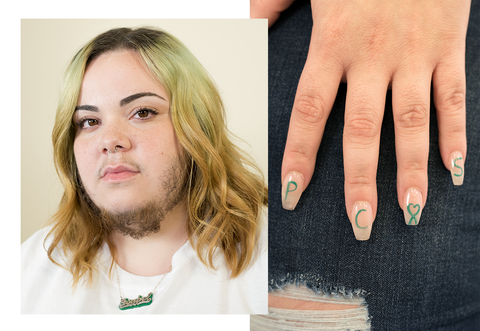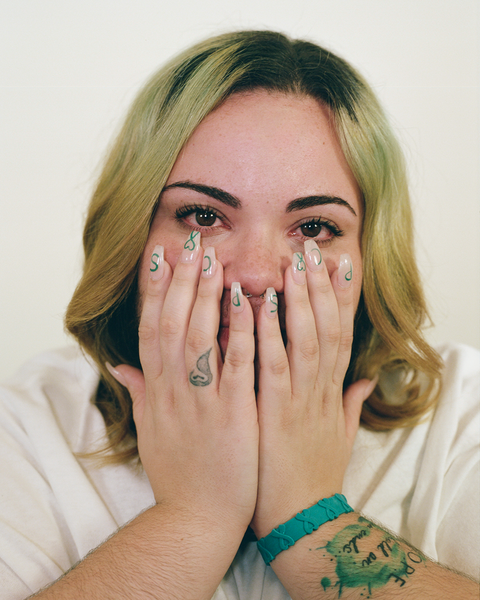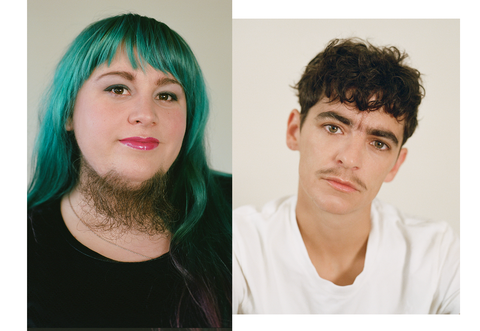“I like to feel ready to leave the house,” she says. “I want to look good.”
Annalisa Hackleman shaved daily starting at age 13, but three years ago she decided to embrace her beard.
That being seen with facial hair equates to looking good would be inconceivable to many women. But not to Hackleman. Not anymore. She’s been wearing her beard with pride for about three years. Today, it’s bigger than her husband’s. The makeup saleswoman from Reno, Nevada, even participated in a beard competition in 2015: “I wanted to go to this event for years and I could never work up the courage to grow my beard out to do it. It ended up being a complete blast.”
Women who openly display the hair on their face are rare, but women with facial hair are not. Hackleman has a condition called hirsutism, defined as excessive hair growth in a male pattern—like on the upper lip, chin, chest, back, or upper abs—in females. It’s the result of the body over-producing androgens (typically thought of as the male sex hormone, although all women have androgens naturally), which is often a symptom of Polycystic Ovarian Syndrome (PCOS), a disease that Hackleman has.

Since learning her facial hair was caused by PCOS, Alma Torres has worked to raise awareness for the disease.
Hirsutism affects as many as 17 percent of women, according to the Encyclopedia of Hair. Doctors even refer to it as “common.”
“Some of my family members have mustaches, and they go through varying beauty regimens to make sure they’re not visible,” says J.D. Samson, an artist and musician best known for her work with the bands Le Tigre and MEN, who, thanks to her high androgen levels, has a mustache. She's become a bit of an icon in the women-sporting-facial-hair world. “Before I was proud of my facial hair, I tried to mask it as much as possible. I definitely took the advice of my mother and sister about when I was supposed to bleach it.”
“Everybody was talking about my beard. It got so bad that I stopped going to school.”
For all women, “there are genetic factors that determine how much hair you have,” explains George T. Griffing, M.D., an endocrinologist and professor of medicine at St. Louis University, pointing out that some ethnic groups are naturally hairier than others. Fair-skinned Europeans and Northern Asians have the least terminal hair (the darker, thicker kind that doesn’t grow on your head), while women of Middle Eastern, Southern Asian, Hispanic, and Mediterranean heritage naturally have more. There’s even an Italian saying: “Donna barbuta, sempre piaciuta,” which is sometimes translated to “everyone loves a woman with a beard.”
It’s a lovely sentiment, but it’s not true. If it were, hirsute women wouldn’t avoid social situations because they’re self-conscious about their hair, as 68 percent of them do, according to a study in the Journal of Psychosomatic Research. It doesn't take a logical leap to believe that, as the International Journal of Women’s Dermatologystates, excess hair can cause significant psychological and emotional distress for women. A U.K. survey found that 30 percent of women with facial hair are depressed.
Samson uses the word “humiliated” when recounting how she felt in 9th grade when a boy ridiculed her about needing to bleach her mustache. And for 24-year-old Alma Torres, a photographer from the Bronx, living with PCOS-induced facial hair as a teen “was like a deep depression.” The first time she removed it was for her eighth grade prom: “I shaved my sideburns—they were thick and long. It was a bad idea. They grew back thicker.” But Torres thought she was doing a fairly good job of hiding in plain sight. It wasn’t until a guidance counselor pulled her aside and asked if anyone was bothering her about her facial hair that she realized other people noticed it as much as she did. “After that, everything went downhill. It was like everybody was talking about it. It was so bad that I stopped going to school. I dropped out.”

"People have thanked me for standing on the stage with a mustache," says musician J.D. Samson.
Torres says that she shaved regularly for eight years, spending hours in the bathroom to get rid of her 5 o'clock shadow. She got multiple piercings in her nose and lips to distract people from her stubble and the rashes that the razor caused.
Hackleman used to shave three or four times every single day to hide her facial hair, a process she started at 13 years old. “My husband would do whatever he could to help me. He would wax my face, but I just couldn’t get it under control. I didn’t want to leave my house. I didn’t want anyone to see me. We weren’t even going to family functions.” This was just five years ago, and for Hackleman, it was “a low point both physically and emotionally.”

"People think that if a woman can grow a beard, she must have crazy body hair, she must be a werewolf," says Hackleman.
We tend to think of hair removal, facial or otherwise, as a consequence of modernity—an outcome of the smooth skin celebrated in advertisements, movies, and, yes, porn. But women have been going to great lengths to eliminate unwanted hair since time immemorial. (We’re probably just spending more money on it nowadays: Waxing will cost the average American woman more than $27,000 over her lifetime.) Hair removal dates back to prehistoric times, when women used the sharpened edges of rocks as razors or pushed two shells together to create tweezers. In ancient Egypt, Greece, and the Roman empire, women removed all of their body hair, and recipes for doing so exist from at least the days of the Pharaohs, says Jill Burke, PhD, a senior lecturer at the University of Edinburgh and author of forthcoming book The Italian Renaissance Nude. “In the Renaissance there was an explosion of treatments for facial appearance,” she says, “and hair removal became more popular in this era because of a new emphasis on the nude form.” In addition to pubic hair, women were removing leg hair, underarm hair, and upper lip hair, Burke explains.
“It’s not a weird fetish. It’s not that he loves my beard. But it really strengthened our relationship to have me not crying every day.”
Beauty standards existed then just as they do now. And all women—hirsute or not—may feel like the world is constantly telling them they have too much hair. “There’s a reason the hair-removal industry makes billions and billions of dollars,” Hackleman says. “They’re there to make money off you feeling like you have to remove your hair.”
Gender is—as ever—at the heart of the issue. To state the obvious: Because more men have facial hair than women, facial hair is considered categorically masculine and, ipso facto, can’t be feminine.
Her band MEN was originally called Hirsute, says Samson, in reference to women with facial hair and the idea of being a "power suit feminist."
From the middle ages through the 17th century, it was believed that “hair was a way for men to get rid of bad things from their bodies, like a kind of excretion,” says Burke. So if a woman was hairy, particularly if she had facial hair, it meant that she “had an imbalance that made her manly”—not just in her appearance but in her disposition, Burke explains. Her contemporaries would have considered her “argumentative and unpleasant; just not good to marry, basically, if you were hairy.”
Fast forward to Charles Darwin’s heyday of the 1800s and hair was “deeply pathologized,” writes Nadine Ajaka in The Atlantic, explaining that for women, it was associated with a “primitive” ancestry. Because pronounced differences in the sexes was seen as an indication of evolutionary superiority, men were allowed to be hairy. That hasn’t changed.
But women like Hackleman and Torres and Samson—who have chosen to fly in the face of all this prejudice and embrace their natural states instead—are proving that having facial hair doesn’t make them any less female. “It’s sad that women feel like they need to live under a restrictive ban of facial hair,” Samson says of how narrowly we define femininity. “In college, I was visiting a friend and I hadn’t bleached my mustache in a long time, and she said, ‘I think it looks really good. You should let this be your thing.’ Since then, I’ve never once thought about changing it. For the most part I’ve really been comfortable with my identity as a woman, but as a different kind of woman.”

"I was very self-conscious. I had very low self-esteem," Torres says of being a teenage girl struggling with having a beard.
Samson is sometimes mistaken for a young boy, but she doesn’t feel hurt when people misgender her—only aware that what may upset them more than how she presents herself is the fact that she's defiant of the norm in the first place. “I don’t look in the mirror and think, ‘I’m doing this as a protest,’ but it definitely came from that place,” she says. “I celebrate my mustache and I think people are uncomfortable with that. I think they're uncomfortable with people who are confident.”
“I’ve really been comfortable with my identity as a woman, but as a different kind of woman.”
One such confident groundbreaker is Harnaam Kaur, a Sikh woman from Britain and arguably the most famous bearded woman today. Kaur has nearly 100,000 followers on Instagram and even walked the runway at London Fashion Week last year. Her posts often show her living a normal life—selfies with Snapchat-filter flower crowns or close-ups of her smoky eye, like most 20-something women—she just also happens to have a beard. “Harnaam also has PCOS; she's one of the women I look up to,” says Torres, who cites Kaur as her inspiration for finally accepting her own facial hair. “She shows women that having a beard can be really beautiful.”
That empowerment is having ripple effects around the world. Torres became a source of inspiration herself after finding Kaur and deciding to stop shaving—that day, she took a ton of pictures and posted them online, captioning them with facts about PCOS. She was flooded with responses. “I didn’t think I would get the support I did, which is kind of crazy,” she says. “People from all over write to me asking me how I did it, how am I so comfortable, how do I not care what people think? I tell them it wasn’t done overnight.”

Hackleman (left) and Samson both decided to keep their facial hair after receiving encouragement and support from a loved one.
In recent years, awareness campaigns like Hairy Awarey and We Can Face It have circulated data on the causes and consequences of female facial hair and encouraged women to embrace what they've got. Then there's Ohio native Balpreet Kaur, another Sikh woman who's made waves over her choice to not remove her facial hair for religious reasons (Sikh faith instructs acolytes not to cut their hair). And 15-time Grammy winner and all-around goddess Adele even admitted to growing a beard post-pregnancy. “I actually have a beard, but I’m proud of it,” she announced to fans at a concert in Glasgow last year. “I call it Larry.”
These women may be brave for proudly stepping forward, but they’re not the first to be celebrated for the very thing that makes them different. Catholic women who wish to be liberated from a bad relationship may invoke St. Wilgefortis, a girl who lived sometime between 700 A.D. and the 11th century, and who, legend has it, grew a beard and mustache after she prayed for help escaping her betrothal to the pagan King of Sicily. Magdalena Ventura became famous in the 17th century when Jusepe de Ribera painted her breastfeeding her son, her long, dark beard flowing down her neck.
“Most people would do everything they could to get rid of a mustache. I celebrate mine.”
But bearded women are never depicted in modern popular culture except as a witch or a circus sideshow. The fourth season of American Horror Story: Freak Showfeatured Kathy Bates as “bearded lady” Ethel Darling. And, of course, there's a bearded woman in the P.T. Barnum movie The Greatest Showman, in theaters now.
Considering how common hirsutism is—affecting as many as 600 million women around the world—this is hardly a fair portrayal. And it's part of a vicious cycle that perpetuates female facial-hair shame.
"There are times when I forget I have a beard and I see people staring at me and I realize that most people have never seen a bearded woman," says Torres.
“I do hope that beauty standards finally change for women and men, and that people have the opportunity to do what makes them feel good about themselves,” Samson says. “I’m lucky to have people who support me for who I am. And I’m lucky that people find me beautiful with a mustache or without one.”
That support system was essential for Hackleman, whose husband was her biggest cheerleader. “It got to the point where he said, ‘You know what? Just let it go. Let your skin heal. Let it grow.’ Not that I needed the permission, but I think I needed the reassurance that there’s nothing wrong with me.”
Many men might not be secure enough to stand proudly next to a partner who displays a stereotypically masculine feature. For Hackleman, it made their marriage better. “It’s not a weird fetish. It’s not that he loves my beard. If I was to shave my face he would be fine,” she says. “But it really strengthened our relationship to have me not crying every day.”
Counterintuitive as it seems, each of these women gained self-esteem when they finally stopped caring about whether they were conventionally beautiful anymore. “I like my beard because I feel more comfortable,” says Torres. “I don’t have to hide behind all the piercings, I don’t have to hide behind the crazy colors in my hair. I can actually feel like me.”
